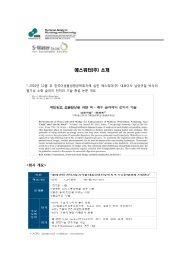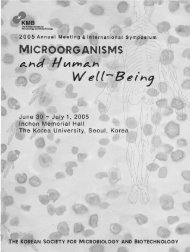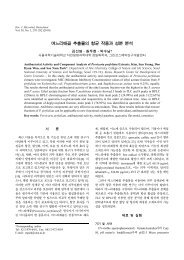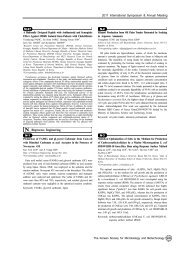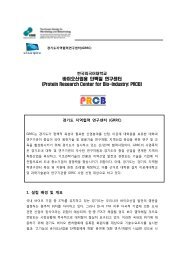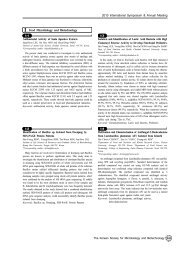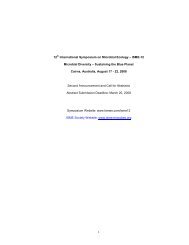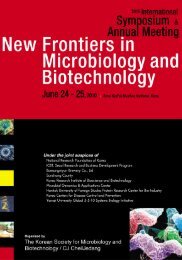J_Environmetal Microbiology and Engineering
J_Environmetal Microbiology and Engineering
J_Environmetal Microbiology and Engineering
You also want an ePaper? Increase the reach of your titles
YUMPU automatically turns print PDFs into web optimized ePapers that Google loves.
J-56<br />
Development of Baeyer-Villiger Monooxygenases Screening<br />
Protocols Using High-throughput screening (HTS) system<br />
Gowoun LEE, Yunjon HAN, Jae Jun SONG <strong>and</strong> Jong Hyun CHOI*<br />
Enzyme-based Fusion Technology Research Team, Microbe-based Fusion<br />
Technology Research Center, Korea Research Institute of Bioscience <strong>and</strong><br />
Biotechnology (KRIBB), 1404 Sinjeong-dong, Jeongeup, Jeonbuk 580-185, Korea.<br />
*Corresponding author: jhchoi@kribb.re.kr<br />
Baeyer-Villiger Monooxygenases (BVMOs) are flavoenzymes that<br />
catalyze the insertion of an oxygen atom in a C-C bond using NADPH<br />
<strong>and</strong> allow the conversion of (cyclic)-ketones into lactones or esters. For<br />
the development of BVMO screening protocol, we used fluorescence based<br />
substrate <strong>and</strong> robot based HTS system. Optimized BVMO screening<br />
protocol for high throughput screening system led to 6,000 clone active<br />
verification per a day was available. As result, we screened the new type<br />
of BVMO positive clone which is named as “GomsoMF” from "Gomso"<br />
metagenomic library. This “GomsoMF” was novel BVMO like enzyme<br />
can convert cyclohexanone to ε-caprolactone. Also this enzyme was<br />
convert cyclopentanone <strong>and</strong> cycloheptanone into δ-valerolactone <strong>and</strong><br />
7-heptanolactone respectively. This new BVMO will be used for the<br />
synthesis of useful biochemicals or the biotechnological application. (This<br />
work was supported by a high throughput screening (HTS)-based<br />
Integrated Technology Development grant from the MEST, <strong>and</strong> a basic<br />
research grant from KRIBB.)<br />
Keywords: Baeyer-Villiger Monooxygenases (BVMOs), high throughput<br />
screening<br />
J-57<br />
The Effect of Gamma Irradiation on Poliovirus, a Model for<br />
Norovirus inoculated in Oyster (Crassostrea Gigas) <strong>and</strong> Effect<br />
of Culture Condition<br />
Jong-Il CHOI, Eu-Ri JO, Pil-Mun JUNG, Jae-Hun KIM, Beom-Suk SONG,<br />
Jae-Kyung KIM, Jong-Heum PARK <strong>and</strong> Ju-Woon LEE*<br />
Team for Radiation Food Science <strong>and</strong> Biotechnology,Advanced Radiation<br />
Technology Institute, Korea Atomic Energy Research Institute, Jeongeup 580-185.<br />
*Corresponding author: sjwlee@kaeri.re.kr<br />
Poliovirus is a recognized surrogate for norovirus, pathogen in water<br />
<strong>and</strong> food, due to the structural <strong>and</strong> genetic similarity. Although radiation<br />
sensitivity of poliovirus in water or media had been reported, there has<br />
been no research in food model such as shellfish. In this study, oyster<br />
(Crassostrea gigas) was incubated in artificial seawater contaminated with<br />
poliovirus, <strong>and</strong> thus radiation sensitivity of poliovirus was determined in<br />
inoculated oyster. The effects of ionizing radiation on the sensitivity of<br />
poliovirus were also evaluated under different conditions such as pH (4-7)<br />
<strong>and</strong> salt concentration (1-15%) in culture broth, <strong>and</strong> temperature during<br />
irradiation. The D10 value of poliovirus in PBS buffer, virus culture broth<br />
<strong>and</strong> oyster was determined to 0.46, 2.84 <strong>and</strong> 2.94 kGy, respectively. The<br />
initial plaque forming unit (PFU) of poliovirus in culture broth was slightly<br />
decreased as the decrease of pH <strong>and</strong> the increase of salt concentration,<br />
but radiation sensitivity was not affected by pH <strong>and</strong> salt contents. However,<br />
radiation resistance of poliovirus was increased at frozen state. These<br />
results provide the basic information for the inactivation of pathogenic<br />
virus in foods by using irradiation.<br />
Keywords: Radiation sensitivity, Poliovirus, Oyster<br />
410 www.kormb.or.kr<br />
Application of Bacillus subtilis 168 to Improve Durability of<br />
Cement<br />
Sung-jin PARK 1 , Jong-Myong PARK 1 , Wha-Jung KIM 2 <strong>and</strong><br />
Sa-Youl GHIM* 1<br />
J-58<br />
1<br />
Dep. of <strong>Microbiology</strong>, Kyungpook National University, Daegu 702-701, Korea.<br />
2<br />
Dept. of Architecture <strong>Engineering</strong>, Kyungpook National University, Daegu<br />
702-701, Korea.<br />
*Corresponding author: ghimsa@knu.ac.kr<br />
Calcium carbonate precipitation, a widespread phenomenon among<br />
bacteria, has been investigated due to its wide range of scientific <strong>and</strong><br />
technological application in concrete remediation. In this study, Bacillus<br />
subtilis 168 which could induce calcium carbonate precipitation, was used<br />
to coat on the cement surface. CaCO3 crystal aggregates <strong>and</strong> organic matrix<br />
molecules of these strains were deposited on the surface of the cement<br />
paste. To verify the effect of coating on the surface of the cement paste,<br />
water permeability of the paste was measured by water immersion test.<br />
In the results, B. subtilis 168 addition showed lower water permeability<br />
than those treated with B4 medium only, suggesting that the precipitated<br />
calcium induced by B. subtilis 168 could be used as a sealing agent to<br />
block water penetration. Also, the calcium precipitation on the surface<br />
of cement mortar could increase the compressive strength of the mortar.<br />
The compressive strength test showed that the cement mortar treated with<br />
B. subtilis 168 showed an improvement of compressive strength.<br />
Keywords: Calcium carbonate precipitation, Bacillus subtilis 168, cement<br />
J-59<br />
Screening Enzyme from Single cell Based Polymerase Fosmid<br />
Cloning<br />
Yunjon HAN, Kyong-Cheol KO, Jong Hyun CHOI <strong>and</strong> Jae Jun SONG*<br />
Enzyme-based Fusion Technology Research Team, Microbe-based Fusion<br />
Technology Research Center, Korea Research Institute of Bioscience <strong>and</strong><br />
Biotechnology (KRIBB), 1404 Sinjeong-dong, Jeongeup, Jeonbuk 580-185, Korea.<br />
*Corresponding author: jjsong@kribb.re.kr<br />
"Metagenomics," which is the genomic analysis of the microbial<br />
community attempts to overcome culturability of various microbes. In<br />
general, the diversity of metagenomic libraries was affected by abundance<br />
of bacteria in environmental sample. Therefore the research of minor<br />
microbial texa in environmental samples remains the biggest challenge.<br />
A new method was developed for enrichment minor bacteria from<br />
environmental samples. This method is based on the Fluorescence in situ<br />
hybridization(FISH), Fluorescence associated cell sorter(FACS) <strong>and</strong><br />
Multiple displacement amplification(MDA). We demonstrated enrichment<br />
minor bacteria from artificial microbial community <strong>and</strong> single cell based<br />
MDA followed by fosmid library construction for enzyme screening. The<br />
Jeongupia naejangsanesis in which the cellulolytic activity is known was<br />
used in the minor microorganism of the artificial microbial community.<br />
As a result, we obtained MDA products from single bacterial cell. And<br />
we could generate fosmid library having an average insert size of 32<br />
kb. Among this fosmid library we screened two new cellulose genes. (This<br />
work was supported by a high throughput screening (HTS)-based<br />
Integrated Technology Development grant from the MEST, <strong>and</strong> a basic<br />
research grant from KRIBB.)<br />
Keywords: Single cell, Multiple displacement amplification, Screening<br />
enzyme





